CURIOUS CAT:Hello, children.
GIRL #1:Hello, Curious Cat.
CURIOUS CAT:Thank you for switcing the lights on. It was a bit dark in here. It's a good thing we have lights, but do you know what makes the lights work?
GIRL #2:Is it electricity?
CURIOUS CAT:That's right, children. Electricity is very important. We use it every day, in all sorts of gadgets and gizmos.
CURIOUS CAT:'Electricity makes all sorts of things work, from little things, like hair dryers, to big things, like all the lights in our houses and schools. And that's because it's a type of energy. In the same way that you eat food to keep you going, machines and gadgets eat electricity to keep them going.'
CURIOUS CAT:But do you know how electricity is made, and how it gets to the sockets in your home?
GIRL #2:No.
GIRL #1:No.
CURIOUS CAT:Well, to find out, you will need to visit the electricity power plant. My friend Mark is waiting to show you round.
GIRL #1:Hooray.
CURIOUS CAT:Off you go.
CURIOUS CAT:'Electricity is made in a place called a power station. There are power stations all over the country, and each needs to be fed fuel to make it run. Different power stations use different types of fuel. Some use coal, some oil, and some even use rubbish. All of these fuels are burned to get energy. But we can also use energy from the wind and flowing water. Even the sun can be used to make electricity. This power station is fuelled by gas.'
MARK:Shall we go have a look?
GIRL #1:Yes.
GIRL #2:Yeah.
MARK:Let's go.
GIRL #2:These are the biggest pipes I've ever seen.
MARK:What you can see is the natural gas fuel that comes into the powered station.
CURIOUS CAT:'The gas comes from deep underground, and because it is colourless, you cannot see it. That's why it has to travel into the power station in these great, big pipes.'
MARK:It comes all the way through our pipework. It goes through into our buildings and gets burnt.
CURIOUS CAT:'So, the first stage of the process is to burn the natural gas to create heat.'
MARK:That heat then turns water into steam. Steam like from a kettle. Very hot. Okay. From here, shall we goand see where these pipe works go…
GIRL #2:Yeah.
MARK:and see where the steam is made? Yes?
GIRL #1:Yeah.
MARK:Okay.
MARK:We're now in the steam turbine hall, where the steam comes together and goes through the turbine. It passes through the blades and turns that turbine to help create energy. As an example, I've got these two little windmills here for you. If you blow into them from the front… you can see they spin, yeah? If you think of your breath pushing that windmill around, it's just like the steam turning round the turbine. The blades inside the steam turbine are really big, and can be up to a metre high, or really small. Here's one to show you. So, it's a quite a bit different to what you got in your hands there, but it does the same job.
GIRL #2:How can it turn around when it's so big and heavy?
MARK:The steam turbine can turn, although it's metal and heavy, through the power from the steam coming through the blades and turning them round.
CURIOUS CAT:'I know that's hard, to imagine steam so powerful to push those heavy blades, so Mark has a demonstration to show the girls how it all works.'
MARK:Okay, girls. I promised showing you electricity. Now, here's a demo of it. At the power station, we have gas coming in that's burnt to create our steam. Here, we have a gas cylinder, which will be set light to, and we'll heat up the water inside this kettle, okay? The steam from there will come through and out the spout to turn… these spoons, which is just like our steam turbine out on the plant. Once it starts to turn, we can then generate electricity through the cable to our houses and the street light.
GIRL #2:Wow.
GIRL #1:Wow.
CURIOUS CAT:'That's amazing. Once the kettle has boiled, the steam pushes out of the spout and turns the turbine made of spoons. So, now we know that an electricity power plant can use different types of fuel to make steam to spin a turbine. But how does this actually make electricity? The answer involves a magnet and a coil of wire.'
MARK:You can see there's plenty of wire that's turned around this plastic. And you have one of these on your steam turbine. If I put a magnet inside, and shake it, what can you see?
GIRL #1:A light.
GIRL #2:Light.
CURIOUS CAT:'Yes, that's right. The turbine moves a magnet that spins inside some wires. This generates electricity in the wires. The electricity travels down the wire and lights up the lamp.'
GIRL #2:How much electricity do you make here?
MARK:The power station can provide enough electricity to power London. Shall I show you the control room?
GIRL #1:Yeah.
GIRL #2:Yeah.
CURIOUS CAT:'Wow. That is a lot of electricity.'
MUSIC
MARK:This is where we control the electricity going out to major cities, homes, towns, and the country. Sometimes we need a little, sometimes we need a lot of power to go out there.
GIRL #2:When do we need lots of electricity?
MARK:Early in the morning when everybody's waking up, so a lot of electricity is gonna be used then. And of course when we all come home from school, from work, that is another time when we need to provide a lot of power.
GIRL #1:How does the electricity get to our homes?
MARK:Well, if we go outside I can show you.
MARK:Okay, girls. Now you can see the end of the process. Here, you can see these large cables going up to this pylon. These long cables go all the way around the country to take the electricity to towns, cities, and your home.
GIRL #1:And what are the cables made of?
MARK:They're made of a metal material to conduct the electricity.
CURIOUS CAT:'A conductor is a material that electricity can flow through easily. When you put a plug into a socket, the electricity travels through the metal pins and not the plastic casing. This is because metal is a good conductor and plastic is not. That's why electrical wires are made of metal. The pylons support the metal cables and take the electricity across the country. All the pylons and wires together are called the national grid. These pylons and wires are very dangerous and you should not go anywhere near them.'
MARK:This is how electricity gets to your homes, how it powers your kettles, your toasters, your ovens, the things you use on a day-to-day basis.
CURIOUS CAT:Hello, children. How was your journey?
GIRL #2:It was great.
GIRL #1:Yeah.
CURIOUS CAT:So, what did you find out about electricity? That electricity can be made out of different fuels like coal and gas.
GIRL #2:'And it's made in a power plant where it gets really hot and spins a turbine, which has a magnet that spins in the middle of some wires.'
GIRL #1:'This makes electricity in the wire. The electricity goes through the wire and is sent all over the country through cables, and ends up in our homes.'
CURIOUS CAT:Wow. That's brilliant work. You know all about generating electricity. Well done, you two. Now I think it's time to say goodbye, and don't forget to turn the lights off on your way out. Goodbye.
BOTH:Goodbye, Curious Cat.
CURIOUS CAT:Goodbye, children.
Video summary
The children learn that different power stations use different types of fuel including coal, oil, and even rubbish.
All of these fuels are burned to make energy.
They also learn that we can use the energy from the sun, wind and flowing water to make electricity.
The children visit a gas fuelled power station where an expert shows them the process of generating electricity.
They see the natural gas coming into the power station through large pipes, before being burned to heat water and produce steam.
The children visit the steam turbine room and the expert uses a gas cylinder, kettle and a turbine made of spoons to generate electricity which then lights up a miniature house and street light.
There is also a demonstration of how electricity is generated by using a magnet inside a coil of wire and a small bulb.
This is from the series: Curious Cat Steel, Electricity, Sewage
Teacher Notes
This clip could be used as an introduction to electricity, provoking a class discussion about different forms of power and its sustainability, which pupils could then undertake as a research project.
Pupils could write a non-fiction report on how electricity is made, using the clip as a reference point.
This clip will be relevant for teaching Science.
This topic appears in KS1/KS2 in England, Foundation Phase in Wales, Foundation and KS1 in Northern Ireland and Early/1st/2nd levels in Scotland.
What happens to our sewage? video
Two children meet Curious Cat, an animated cat who asks them if they would like to find out what happens to our sewage once it leaves our homes.
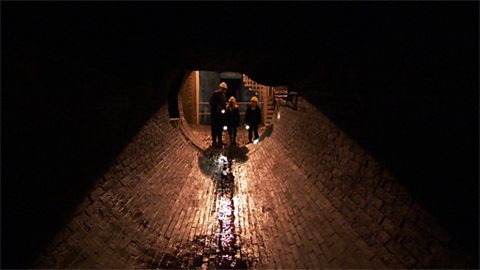
How are bricks made? video
With the help of Curious Cat, two children visit a brick factory to find out they bricks are made.
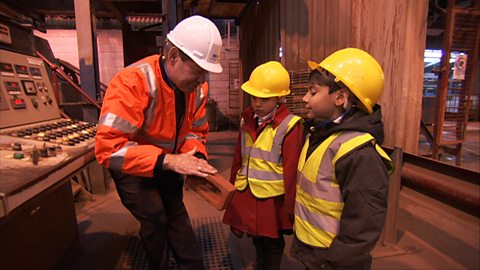
How are TV programmes made? video
Two children find out how TV programmes are made and how they reach your TV at home.
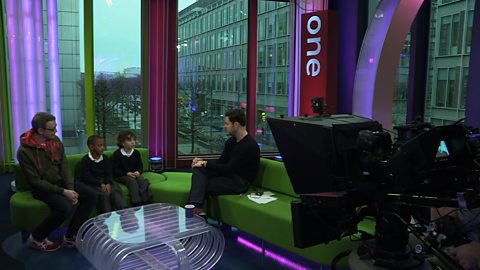
How is glass made? video
With the help of Curious Cat, two children find out how flat glass for windows is made.
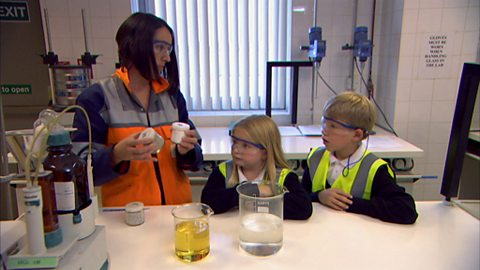
How is paper made? video
Two children meet animated character Curious Cat, who asks them if they would like to find out how paper is made.

How is wool made? video
Curious Cat, an animated character, helps two children find out more about how wool is made.
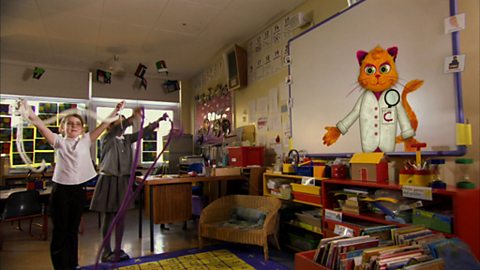
How is steel made? video
Curious Cat, an animated cat, asks two children if they’d like to find out how biscuit tins are made.
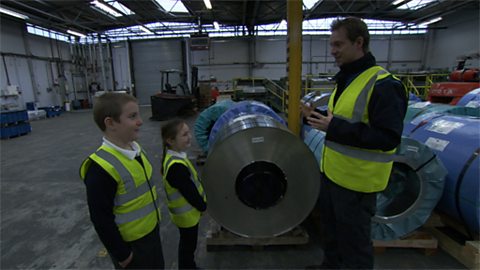
How are crayons made? video
With the help of Curious Cat, two children visit a crayon factory to find out how they are made.
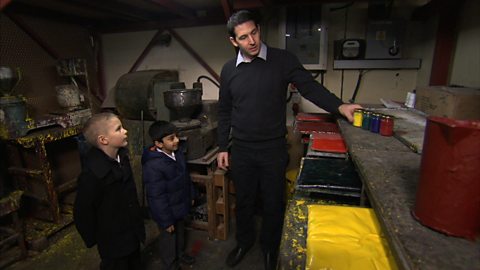
Ěý